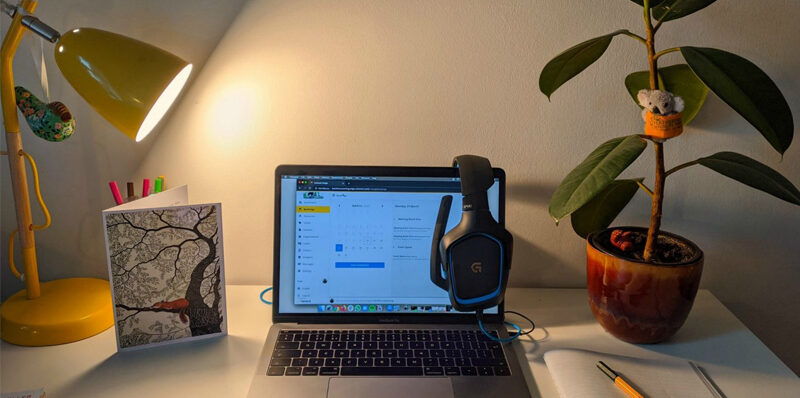Coronavirus has driven a lot of our social interactions into the virtual space. Most of us are working just as long and hard as we would otherwise—or sometimes, even more—but over virtual platforms like Zoom or Slack. While technology has helped us continue to stay in touch and get our work done, it can all be very overwhelming. You’re likely experiencing exhaustion from staring at your screen all day or feeling burnt out by the excessive use of technology, what is now being referred to as zoom fatigue.
Why are virtual interactions so tiring? Let’s outline 4 major factors:
The physical challenge
While a regular workday might require long hours on a chair, the experience of sitting has intensified while working at home, resulting in back pain, headaches, painful feet, and more. Add to that the fact of staring at a screen for prolonged periods resulting in dry eyes, poor posture, etc.
The mental challenge
The prolonged screen time (over not just computers, but also TVs and phones) requires our brain to process information differently. There are so many stimuli flying at it from different directions, and dealing with all that without making too many errors can be quite draining. Add to that, not all such virtual calls help complete work—they instead create a list of things to do after the call and we end up playing catch up with this ever-growing list.
The socio-emotional challenge
Remember the famous Mehrabian study? It suggested that 93% of our communication is non-verbal, that includes facial expressions, tone, body language, etc. But what if that body language is reduced to a bunch of talking heads on a screen? And issues like connectivity or frozen screens just exacerbate the problem. We lose out on almost all the subtext that makes our social interaction so rich. We are not used to making decisions without this subtext. So unless they’re carefully crafted, virtual conversations can easily be more tiring than energizing.
The challenge of the self
You know how people alone on a desert island or in solitary confinement lose track of time? Strangely, a similar phenomenon has started happening with this work-from-home situation. People are on call all the time. There is no natural break in the day which marks the end of the working day (for example, the evening commute) or the start of the day for that matter. The clothes that mark your professional persona have been sitting idle in your closet and many of the affirming activities of everyday life like playing a sport or going to a yoga class are now not possible in the same way. Naturally, the idea of “who I am” starts to erode ever so slowly. In other words, the sense of self, the boundaries that allowed you to form your identity gets disturbed, making it hard to be the best version of yourself.
So what can we do about it?
The secret lies in a single principle: recovery. We need to build in rituals and processes that allow our body and mind to recover from the stress—regularly, many times a day. It is the same principle that works in physical training. A muscle is stretched through exercise and then allowed to recover before putting more pressure on it.
10 Ways to Recover from Zoom Fatigue
- Intersperse video calls with physical movement. Walk around the room, do sit-ups, or stretch. Move at least once every hour and use this opportunity to stay hydrated.
- Allow some buffer time between calls which you can use for your recovery rituals. It could be as simple and short as drinking a glass of water, breathing exercises and stretches to release the muscles, or solving a quick puzzle to energize your brain. Given much of our work is over a screen, adopt rituals that do not involve any screen time.
- Periodically look away from the screen and at something far away like the sky, birds, etc. This will relax your eyes and de-stress you.
- Use lower-tech interfaces where possible (like phones or emails) to get work done. You can move about while speaking on the phone, which gives you a physical break from screen time, and managing email at pre-determined slots during the day will help prioritize work and relegate less urgent activities/decisions away from Zoom/Slack meetings.
- Try to demarcate a space at home where you will work from. And leave the other spaces free for other things. This will create certain boundaries for you with others at home as well and reduce the strain of distraction while working.
- Build some rituals around work hours. Have a start and end work time so you can stay in control of your time. It will retain some structure which will also be useful once lockdown lifts and work goes back to a (new?) normal.
- Start meetings online with a check-in and ask people how they are rather than directly jumping into the task at hand. Review some guidelines for how you are going to work together if that is helpful. Similarly, ask questions as the group closes the conversation (called check-out)—was the call useful, how do they feel, etc.
- Try to sleep and wake at the same time every day and try to take regular breaks that mark the passing of the day. Finding a rhythm to your day helps your body and mind relax and deal with external stressors much better.
- Find one thing to do every day that affirms your identity. For example, both of us need to dance everyday (especially through this stressful time) because it keeps us connected to who we are and will be outside the lockdown.
- Start a new project that is not work related that gives you space to express yourself and will be relevant even post-lockdown.
All of these things will help you stay grounded through this chaotic time and recover quickly from Zoom fatigue. Stay safe.
This article was first published on HBR Ascend.
